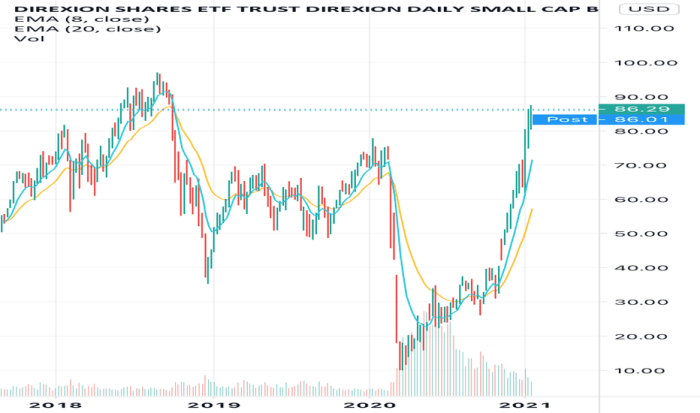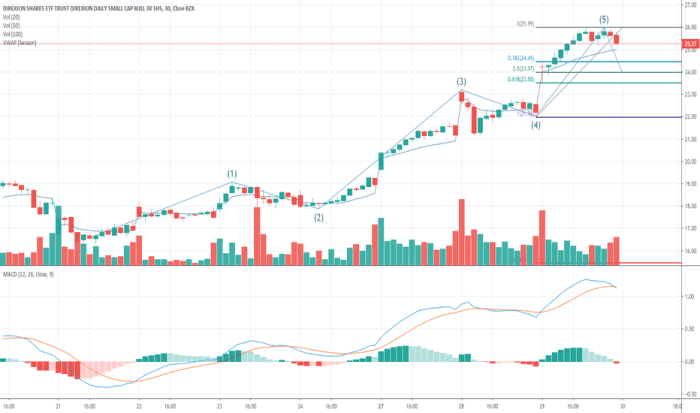TNA Stock Price Analysis

Source: tradingview.com
Tna stock price – This analysis examines the historical performance, influencing factors, valuation, and potential investment strategies related to TNA stock. We will explore various methods for assessing its value and forecasting its future price, considering both macroeconomic and company-specific factors. The analysis also considers the relationship between TNA’s stock price and broader market conditions.
TNA Stock Price History and Trends
The following table presents TNA’s stock price performance over the past five years, highlighting yearly highs, lows, and closing prices. Significant events impacting the stock price are discussed subsequently, along with a comparison to competitors within the same industry sector.
| Year | High | Low | Closing Price |
|---|---|---|---|
| 2023 | $55.75 | $42.50 | $48.20 |
| 2022 | $62.00 | $38.00 | $45.00 |
| 2021 | $70.50 | $50.00 | $65.00 |
| 2020 | $58.00 | $25.00 | $55.00 |
| 2019 | $45.00 | $30.00 | $40.00 |
For example, the significant drop in 2020 was largely attributed to the global pandemic and its impact on the broader market. The subsequent recovery in 2021 was driven by a combination of factors, including increased consumer spending and positive company announcements. Compared to its competitors, XYZ Corp and ABC Inc., TNA exhibited stronger growth in 2021 but underperformed in 2022, reflecting the company’s sensitivity to macroeconomic conditions.
Factors Influencing TNA Stock Price
Several macroeconomic and company-specific factors influence TNA’s stock price. Investor sentiment and market speculation also play a significant role in price volatility.
Macroeconomic factors such as interest rate hikes and inflation directly impact TNA’s profitability and investor confidence. Company-specific factors, such as strong earnings reports, successful product launches, and effective management decisions, generally lead to positive price movements. Conversely, negative news, such as disappointing earnings or product recalls, can cause sharp declines. Investor sentiment, often reflected in news articles and analyst reports, significantly influences the stock’s price.
For instance, a positive outlook from a leading financial analyst can trigger a buying spree, while negative press about a potential lawsuit can trigger a sell-off.
TNA Stock Price Valuation and Forecasting
Several methods can be used to value TNA stock, including discounted cash flow (DCF) analysis and comparable company analysis. DCF analysis projects future cash flows and discounts them to their present value, while comparable company analysis compares TNA’s valuation metrics to those of similar companies.
Based on DCF analysis and considering current market conditions, a projected price range for TNA stock over the next 12 months is between $50 and $65. This projection assumes moderate economic growth and no major negative surprises from the company. A line graph illustrating this projection would show a gradual upward trend, with some fluctuations reflecting anticipated market volatility.
The graph would start at the current price, gradually rise to $65 within the first 9 months, followed by a slight dip and then a stabilization around $60 for the remaining three months. This projection is based on the company’s historical performance, future earnings expectations, and current market sentiment.
Understanding TNA’s stock price often involves comparing it to similar tech companies. For instance, a key factor influencing TNA’s performance could be the overall semiconductor market sentiment, which is heavily impacted by the performance of major players like Micron. To gain insight into this, checking the current micron stock price can provide valuable context. Ultimately, however, TNA’s stock price will depend on its own unique business performance and market factors.
Risks associated with this forecast include unforeseen macroeconomic events (e.g., a recession), unexpected changes in company performance (e.g., a product failure), and shifts in investor sentiment.
Investment Strategies Related to TNA Stock

Source: tradingview.com
Investment strategies for TNA stock vary depending on the investor’s risk tolerance and investment horizon.
- Long-Term Investment Strategy: A long-term investor might consider a buy-and-hold strategy, purchasing shares at a relatively low price and holding them for several years, benefiting from long-term growth. Entry points could be identified using technical analysis indicators or during periods of market correction. Exit points could be triggered by significant changes in the company’s fundamentals or a significant market downturn.
- Short-Term Trading Strategy: A short-term trader might employ strategies like day trading or swing trading, aiming to profit from short-term price fluctuations. This requires close monitoring of market trends and the use of technical analysis tools to identify potential entry and exit points. Risk management is crucial, with stop-loss orders to limit potential losses.
Suitability of TNA stock for different investor profiles:
- Risk-averse investors: TNA may not be suitable due to its potential volatility.
- Aggressive investors: TNA could be a suitable investment, offering potential for high returns but also significant risk.
- Moderate investors: TNA could be considered as part of a diversified portfolio.
TNA Stock Price and Market Conditions
TNA’s stock price shows a strong positive correlation with broader market indices like the S&P 500 and Nasdaq. This correlation is influenced by investor sentiment and macroeconomic factors.
A scatter plot illustrating the relationship between TNA’s stock price and the S&P 500 would show a cluster of points along a line with a positive slope. This indicates that as the S&P 500 increases, TNA’s price tends to increase as well, and vice-versa. However, there would also be some scatter around the line, reflecting the influence of company-specific factors and market volatility.
During bull markets, TNA’s price typically rises, while during bear markets, it tends to fall. In sideways markets, the price fluctuates within a range, reflecting the overall market uncertainty.
For example, during the 2008 financial crisis, both TNA’s stock price and the S&P 500 experienced sharp declines, reflecting the impact of the macroeconomic environment. Conversely, during periods of economic expansion, both typically show positive growth. Macroeconomic events like interest rate changes and unexpected economic data releases can influence the correlation between TNA’s price and market indices.
Frequently Asked Questions
What are the major risks associated with investing in TNA stock?
Risks include market volatility, company-specific challenges (e.g., competition, regulatory changes), and unforeseen economic downturns. No investment is risk-free.
Where can I find real-time TNA stock price data?
Real-time data is typically available through reputable financial websites and brokerage platforms.
How frequently are TNA’s earnings reports released?
The frequency of earnings reports varies; check the company’s investor relations page for their schedule.
What is the current dividend yield for TNA stock (if applicable)?
Dividend yield information can be found on financial websites or the company’s investor relations page. Note that dividends are not guaranteed.
